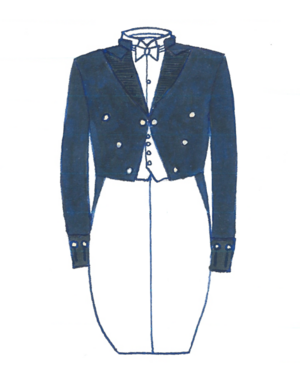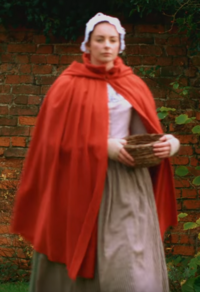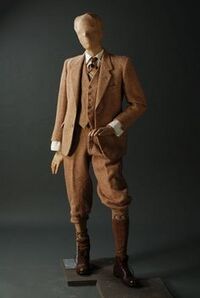Nortish dress codes: Difference between revisions
No edit summary |
|||
| Line 2: | Line 2: | ||
==Court Dress== | ==Court Dress== | ||
[[File:GNCourtDress.png|thumb|right|Velvet court dress.]]Court dress is the most formal dress code and is appropriate at royal, state and official occasions such as royal courts, levées, balls, ceremonies, investitures, coronations, funerals and religious services, government and diplomatic occasions, as well as at the ceremonies of municipal, legal, academic and other 'dress' corporations. As with most formal dress codes, it comes in both 'morning' and 'evening' forms. | [[File:GNCourtDress.png|thumb|right|Velvet court dress.]]Court dress or 'full dress' is the most formal dress code and is appropriate at royal, state and official occasions such as royal courts, levées, balls, ceremonies, investitures, coronations, funerals and religious services, government and diplomatic occasions, as well as at the ceremonies of municipal, legal, academic and other 'dress' corporations. As with most formal dress codes, it comes in both 'morning' and 'evening' forms. | ||
The cloth suit is worn during the day. It consists of a dress blue tailcoat with pointed cloth lapels, standing collar and three silver buttons. It is cut small and cannot be closed, but the two halves are linked with a chain. It is worn with dress blue breeches, white stockings, silver buckled court shoes, black waistcoat, stiff bosom shirt, stiff standing collar and a white bowed necktie. A dress blue morning suit may be worn instead with buttons replaced with silver buttons. | The cloth suit is worn during the day. It consists of a dress blue tailcoat with pointed cloth lapels, standing collar and three silver buttons. It is cut small and cannot be closed, but the two halves are linked with a chain. It is worn with dress blue breeches, white stockings, silver buckled court shoes, black waistcoat, stiff bosom shirt, stiff standing collar and a white bowed necktie. A dress blue morning suit may be worn instead with buttons replaced with silver buttons. | ||
| Line 18: | Line 18: | ||
Court livery is the cloth full dress uniform worn by male members of the Royal household, the [[Royal Army (Great Nortend)|Royal Army]], the [[Navy Royal (Great Nortend)|Navy Royal]], the Civil Service and the Diplomatic Services on occasions demanding court dress. The various classes or ranks are denoted by increasing quantities of gold and silver embroidery, and in the case of military uniforms, by rank insignia. The day form of military, naval, civil and diplomatic court livery has embroidery across the front; however, the evening form has pointed lapels as in the standard court suit. Court livery is also worn by male domestic servants. | Court livery is the cloth full dress uniform worn by male members of the Royal household, the [[Royal Army (Great Nortend)|Royal Army]], the [[Navy Royal (Great Nortend)|Navy Royal]], the Civil Service and the Diplomatic Services on occasions demanding court dress. The various classes or ranks are denoted by increasing quantities of gold and silver embroidery, and in the case of military uniforms, by rank insignia. The day form of military, naval, civil and diplomatic court livery has embroidery across the front; however, the evening form has pointed lapels as in the standard court suit. Court livery is also worn by male domestic servants. | ||
== | ==Undress== | ||
Undress is worn on formal non-state occasions which do not demand court dress. It is often worn at weddings, funerals, christenings, feast day religious services, dinners at restaurants, operas, concerts, balls and the like. Many people wear undress regularly at dinner, often on Sunday dinners. | |||
It consists of a grey or dress blue morning coat and a black or dress blue evening coat. Both are cut identically, with pointed lapels in cloth for morning and in silk for evening. The evening coat is the same as the | It consists of a grey or dress blue morning coat and a black or dress blue evening coat. Both are cut identically, with pointed lapels in cloth for morning and in silk for evening. The evening coat is the same as the full dress velvet coat when made in wool barathea, albeit with black buttons which can usually be removed. Both morning and evenings coats are worn with a stiff bosom shirt and detachable standing collar (either winged or straight) and detachable single cuffs. | ||
The morning coat is worn with a coloured bowed tie or {{wp|necktie|tailed tie}}, pastel waistcoat, grey striped or chequered trousers, and black boots. The evening coat is worn with a bowed tie, either white or black, white waistcoat, plain or striped dress blue trousers with a double stripe of silk ribbon, and black shoes. | The morning coat is worn with a coloured bowed tie or {{wp|necktie|tailed tie}}, pastel waistcoat, grey striped or chequered trousers, and black boots. The evening coat is worn with a bowed tie, either white or black, white waistcoat, plain or striped dress blue trousers with a double stripe of silk ribbon, and black shoes. | ||
Liveried servants wear | Liveried servants wear undress in the form of a evening dress coat with striped waistcoats, both in varied colours and with white bow ties. | ||
==Informal dress== | ==Informal dress== | ||
Revision as of 10:54, 1 September 2020
Nortan clothing, or Nortch clothing refers to the modern and traditional clothing attire worn in Great Nortend, not just in Nortend. Nortan clothing is generally quite similar to Western clothing; however, it is a distinct variety and retains a unique appearance.
Court Dress
Court dress or 'full dress' is the most formal dress code and is appropriate at royal, state and official occasions such as royal courts, levées, balls, ceremonies, investitures, coronations, funerals and religious services, government and diplomatic occasions, as well as at the ceremonies of municipal, legal, academic and other 'dress' corporations. As with most formal dress codes, it comes in both 'morning' and 'evening' forms.
The cloth suit is worn during the day. It consists of a dress blue tailcoat with pointed cloth lapels, standing collar and three silver buttons. It is cut small and cannot be closed, but the two halves are linked with a chain. It is worn with dress blue breeches, white stockings, silver buckled court shoes, black waistcoat, stiff bosom shirt, stiff standing collar and a white bowed necktie. A dress blue morning suit may be worn instead with buttons replaced with silver buttons.
The velvet suit is worn during the evening. It is much as the same as the cloth suit; however, the coat and breeches are of dress blue silk velvet with lapels covered in black silk grosgrain. Furthermore, the buttons and buckles are in silver gilt and a white waistcoat is worn. It is permissible to wear an ordinary cloth full dress evening tailcoat with buttons replaced with gilt buttons.
Clerical court dress consists of a knee-length apron cassock with sash. In the evening, the apron is trimmed in silk.
Robed court dress
Robed court dress is worn at official, state or ceremonial events, such as investitures, courts of law, Parliament, coronations and religious services. They are contrasted with social events such as courts, garden parties, luncheons, dinners, banquets, balls and levées where unrobed court dress is worn.
Robed court dress requires persons to wear academical gowns and hoods, chivalrous mantles and tippets, legal robes and tabards, judicial robes, mantles and casting-hoods, clerical gowns and mantles, corporate and prelatial robes, and wigs. Often only officials or an official party wear robed court dress. For example, only Parliamentary officers such as the Speaker, Knight-Lieutenant, Lord Steuard, clerks and serjeants wear robed court dress daily whilst other members of Parliament wear unrobed court dress.
Court livery
Court livery is the cloth full dress uniform worn by male members of the Royal household, the Royal Army, the Navy Royal, the Civil Service and the Diplomatic Services on occasions demanding court dress. The various classes or ranks are denoted by increasing quantities of gold and silver embroidery, and in the case of military uniforms, by rank insignia. The day form of military, naval, civil and diplomatic court livery has embroidery across the front; however, the evening form has pointed lapels as in the standard court suit. Court livery is also worn by male domestic servants.
Undress
Undress is worn on formal non-state occasions which do not demand court dress. It is often worn at weddings, funerals, christenings, feast day religious services, dinners at restaurants, operas, concerts, balls and the like. Many people wear undress regularly at dinner, often on Sunday dinners.
It consists of a grey or dress blue morning coat and a black or dress blue evening coat. Both are cut identically, with pointed lapels in cloth for morning and in silk for evening. The evening coat is the same as the full dress velvet coat when made in wool barathea, albeit with black buttons which can usually be removed. Both morning and evenings coats are worn with a stiff bosom shirt and detachable standing collar (either winged or straight) and detachable single cuffs.
The morning coat is worn with a coloured bowed tie or tailed tie, pastel waistcoat, grey striped or chequered trousers, and black boots. The evening coat is worn with a bowed tie, either white or black, white waistcoat, plain or striped dress blue trousers with a double stripe of silk ribbon, and black shoes.
Liveried servants wear undress in the form of a evening dress coat with striped waistcoats, both in varied colours and with white bow ties.
Informal dress
Informal dress consists of day town dress and evening lounge dress.
Town dress is worn in 'town' and in the country on more formal occasions such as at church, luncheons &c. It consists of matching woollen coat, waistcoat and trousers, usually worn with a turned collar and tailed tie.
Lounge dress consist of a casual 'smoking' jacket and dinner trousers, usually worn with a soft shirt and bowed tie.
Country dress
The costumes worn in the countryside of rural Great Nortend varies greatly between localities and employment in details, but generally they are of the same basic design. Both the labouring classes and the gentle classes wear similar clothing in the country, although materials, quality, trimming and cost differ. It is also often worn when travelling, exercising or playing sports.
A linen shirt, or chemise is worn as the under garment. Men will wear long underlinens covering the legs, and the shirt has a soft collar attached with buttons which often closed with a woollen necktie. Women wear a pair of minimally boned bodices or fully boned stays over the chemise to support the chest depending on occupation.
Men typically wear "knees" with thick woollen stockings with garters over their underlinens, held up by braces. Knees are similar to knickerbockers or plus-fours and are usually in browns, dark blues or greens. Women wear a number of petticoats, usually two or three, over their chemise and bodice. These are usually around ankle length, although they tend to be around mid-calf length in the North. Over the petticoats a long skirt is worn. Usually skirts are at the natural waist, and are in a durable woollen fabric. Woollen stockings are worn with garters.
Over the shirt, men wear a woollen coat which is sually 'sack like' and single breasted with notched labels. It does not always match the knees and often has a contrasting collar in a corduroy or felt. A waistcoat or jumper may be worn under the coat. Women over their chemise and bodice wear a short-gown with collar, often an apron, and a shawl over the shoulders and fastened at the front.
A woollen flat cap, a felted bonnet or felt hat in subdued colours is worn by men. A linen cap, which covers the hair, and a woollen or felt bonnet or hat thereover is worn by women. In summer, a straw hat may be worn instead by both sexes. For footwear, leather boots or wooden soled clogs with leather uppers are worn by all, although men typically use laces and women buckles.
This page is written in Erbonian English, which has its own spelling conventions (colour, travelled, centre, realise, instal, sobre, shew, artefact), and some terms that are used in it may be different or absent from other varieties of English. |




